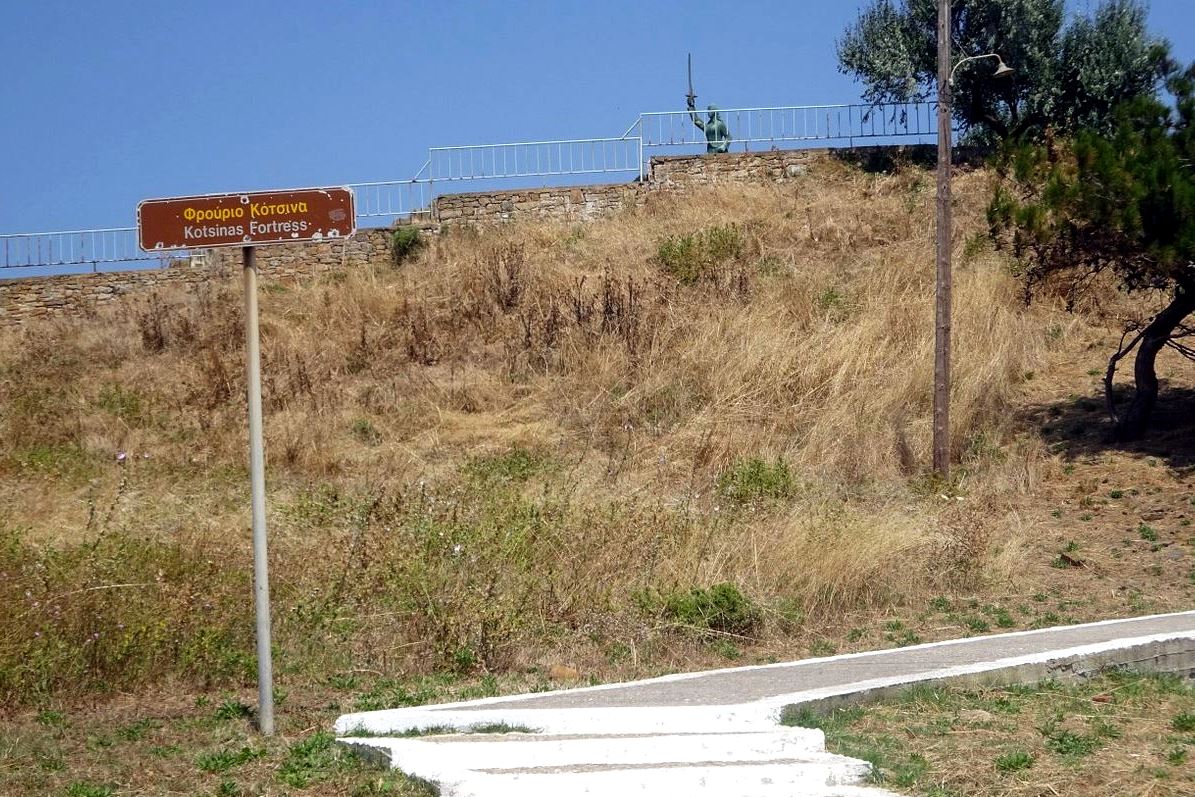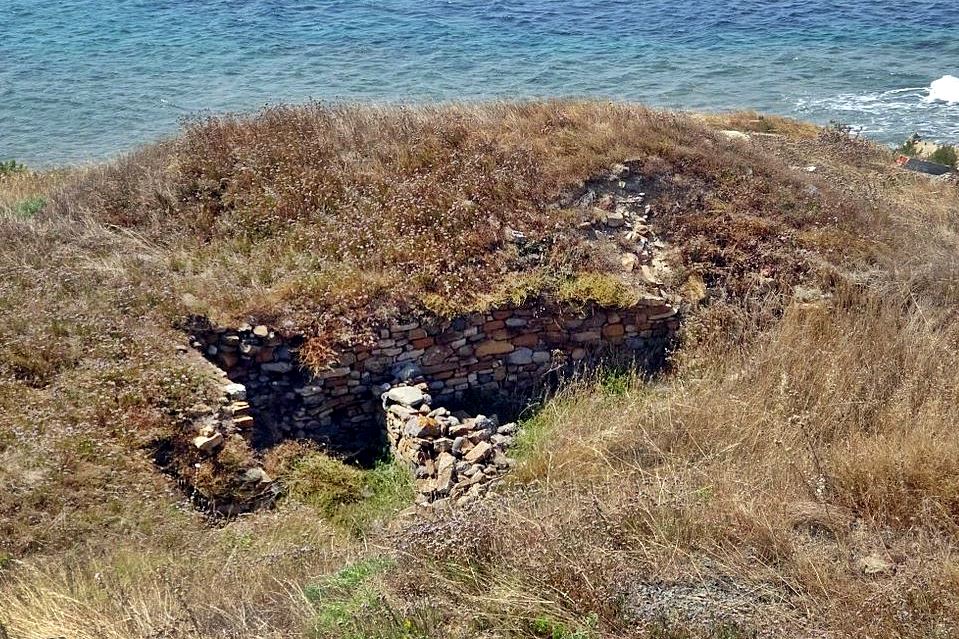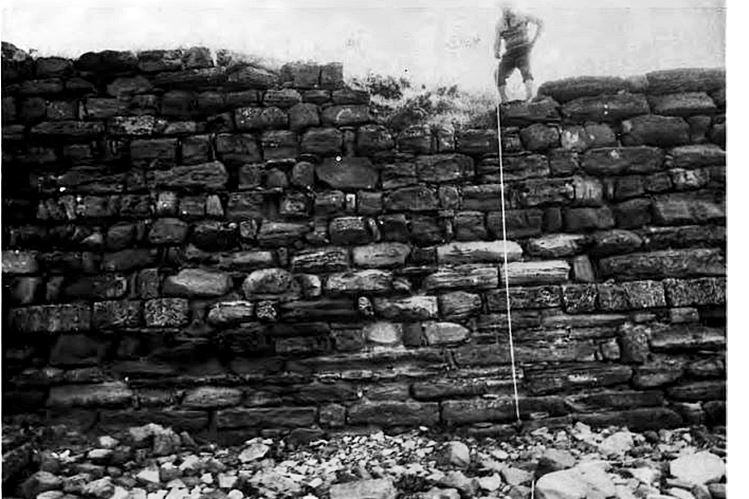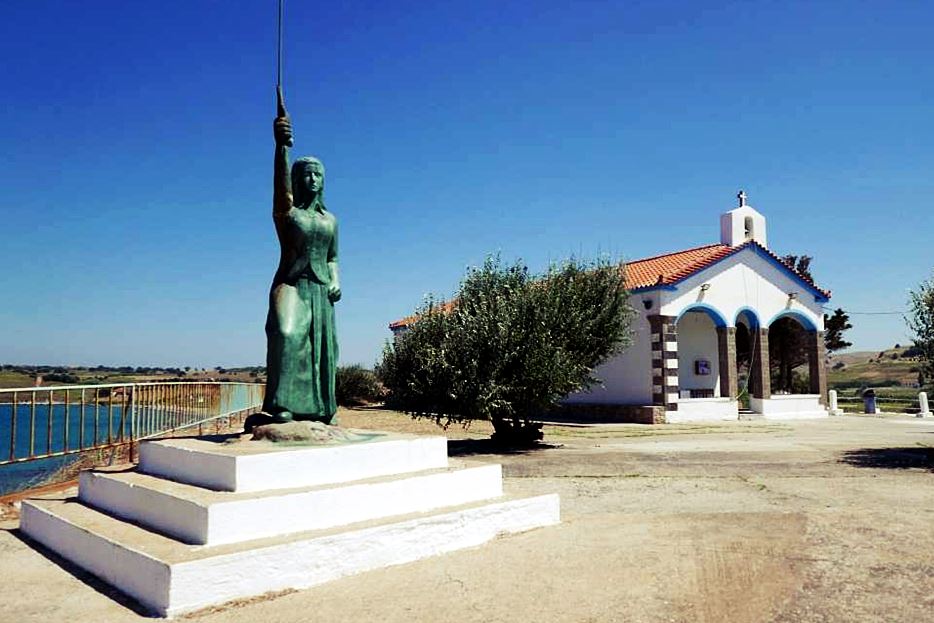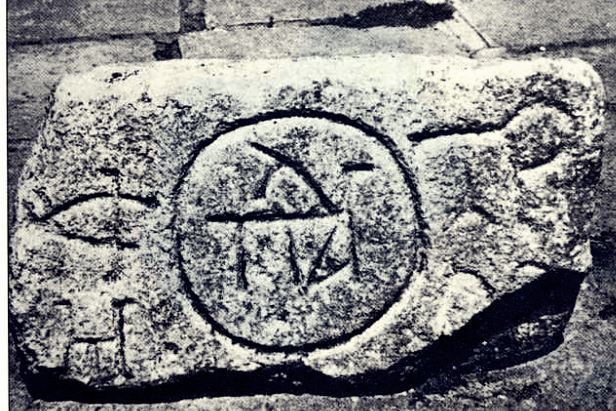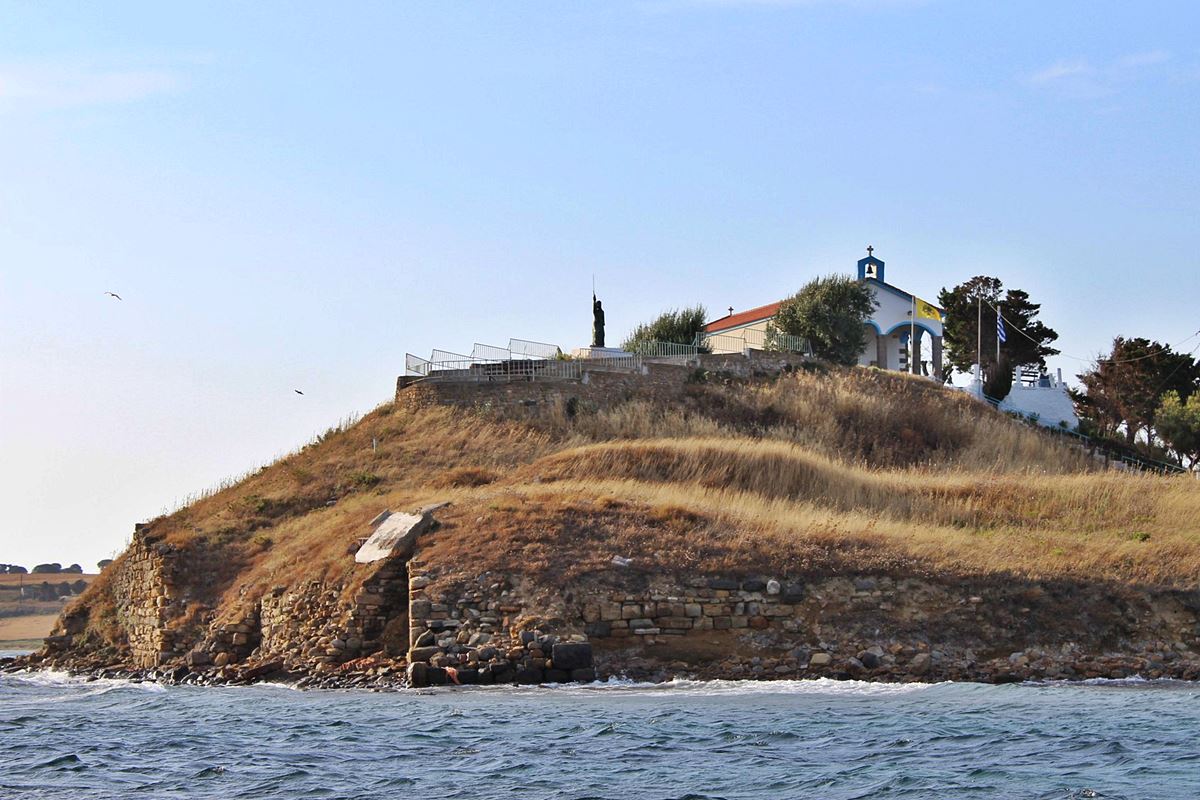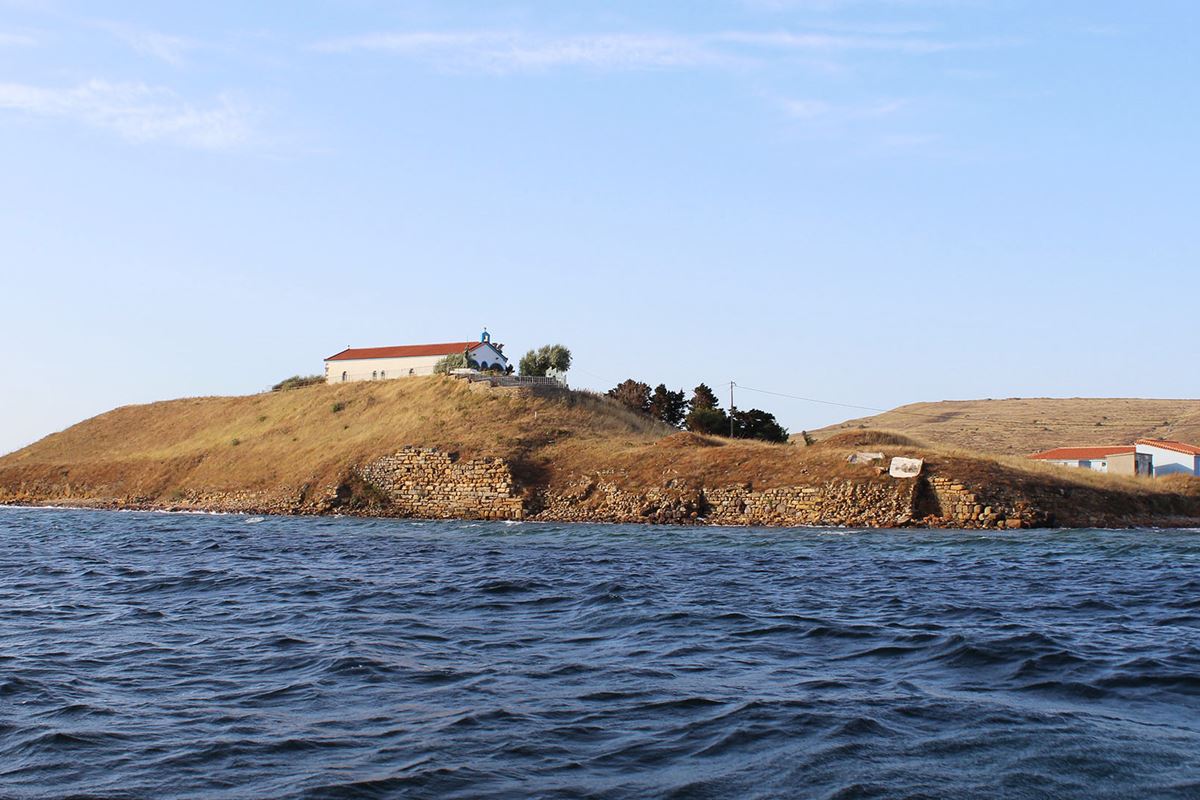Kotsinas, Lemnos, Lesbos,North Aegean
Castle of Kotzinos
| Location: |
| At the village Kotsinas of Lemnos |
| Region > Prefecture: | 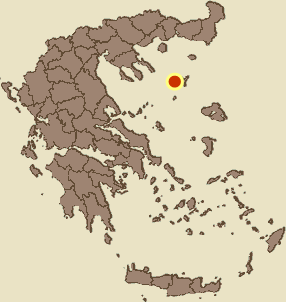 |
| North Aegean Lesbos | |
| Municipality > Town: | |
| City of Lemnos • Kotsinas | |
| Altitude: | |
| Elevation ≈ 20 m |
| Time of Construction | Origin | |
| 13th century | FRANKISH |
|
| Castle Type | Condition | |
| Castle Ruins |
Few Remains
|
Few traces of a coastal castle in the small village of Kotsinas (medieval name Kotzinos) in northern Lemnos. The castle was located on the coast on an artificial hill where today the modern church of Zoodochos Pigi and the statue of Maroula (whose history is connected to the castle, see below) are located.
It is the only castle in Greece that has been built on an artificial hill.
History
The name Kotzinos or Kotzinas or Kokkinos is mentioned for the first time as a location of the Venetian Trade in the year 1136, while as a castle at the middle of the 14th century.
Kotzinos was the most important city and commercial port of Lemnos after Paleokastro (Myrina). It is located on the northern side of the island near the ancient city of Hephaestia, which is 5 km to the northeast, at the entrance of the bay.
The gradual disuse of the port of Hephaestia during the Late Roman Period, due to alluvium, created the need for a port in Kotsinos, which developed into an important city during the Byzantine Period and especially after the 12th century, when it became a port of the Venetians.
Kotzinos appears in the sources for the first time in 1136, in a document by which the archbishop of Lemnos Michael grants the small church of Agios Vlasios to the Venetians who are settled there, satisfying their request. The request of the Venetians to have a temple in Kotsinos means that there was already a small community of Venetians there with commercial activity, in the context of the expanded commercial privileges that John II Komnenos was forced to grant to Venice in 1126.
The existence of a castle in Kotzinos is attested for the first time in a chrysobullon of the emperor John V Palaiologos in 1355, regarding the properties of the Monastery of Philotheos of Mount Athos in Lemnos, in which it is mentioned that the castle colmmander at Kotsinos was a certain Tzymalos, son of Basil.
So the castle existed in the middle of the 14th century, but it is very likely that it was built earlier, in the 13th century, and specifically in the period 1207 to 1278, when Lemnos was a Venetian duchy (of the Navigajoso family) subject to the Latin Emperor of Constantinople.
In 1403, after the return of Manuel II Palaiologos from his European tour, his nephew John VII Palaiologos, who had took the throne in his absence, was forced to leave Constantinople and come to Lemnos from where he left immediately to become despot in Thessaloniki, but it seems that Lemnos remained his property. After the death of John VII in 1408, Kotzinos and Lemnos passed to his widow Eugenia, daughter of the Genoese ruler of Lesvos Francis II Gattiliusi. After the death of Eugenia in 1440, the Gattiliusi claimed Lemnos aand took Kotzinos and after 1453 the whole island.
According to Laonikos Chalkokondylis, in 1442 Constantine Palaiologos (later the last emperor) passed through Kotzinos from the Morea on his way to Constantinople, where he had been invited by his brother and emperor John VIII to help deal with the growing threat of the Ottomans.
There, Constantine was attacked by a Turkish fleet under Ahmet, who besieged him at Kozinos for 27 days. Despite the use of cannons by the Turks, the castle held out and eventually Constantine managed to escape and reach Constantinople. However, during the siege, Constantine’s second wife, Ekaterini Gatelouzou, miscarried and died in Kotzinos.
In 1455, the inhabitants of Lemnos, resentful of the island's governor Nikolo Gattiliusi, brother of the ruler of Lesbos, expelled him with the help of the Turks who occupied the island for a while. But the following year a papal fleet under Cardinal Ludovico Trevisan liberated some islands in the North Aegean and among them Lemnos.
In 1460 the Venetians (who occupied Lemnos after the departure of the papal fleey) but will be driven out by the inhabitants. In the same year, Lemnos will be taken over by Demetrius Paleologos, deposed Despot of Mystras, who was given Lemnos and some old possessions of the Genoese (Imbros, Thassos, Samothraki) as a reward for the surrender of Mystras to Mohammed II. (In a few years Demetrius would fall out of favor and die penniless in Adrianople in 1470, but that is another story.)
In 1466, the Venetians returned: A Venetian fleet under Vettore Cappello captured the islands of Lemnos, Thassos, Imbros. In 1470 the Turkish admiral Mahmut Pasha attacked Kotzinos and then the city outside the walls was destroyed, but he failed to capture the island's castles (Kotzinos and Myrina) and was forced to withdraw from Lemnos.
In 1478 Kotzinos became the target of another unsuccessful Ottoman siege under Suleiman Pasha. The castle was successfully defended by Antonio Loredano, while in this battle the legend of Maroula was created.
Finally, Lemnos was handed over by the Venetians to the Turks in 1479 at the end of the First Venetian-Turkish War with the Treaty of Constantinople.
In 1655, the Venetians came back for a while and took the castle of Kozhinos from the Turks. They were forced to leave for good in 1657 and then they completely destroyed the castle of Kotzinos, which, however, seems to have already been largely destroyed.
As early as the 16th century, the Kotzinos castle was mentioned by the traveler André Thevet as uninhabited. Kotzinos is also mentioned by Belon in 1546 who describes it as a large village with a ruined castle.
In 1858 it is mentioned by visitors as an anchorage with few shops and no houses. The church of Panagia (today Zoodochos Pigi) and the underground “holy source” inside the castle area are also reported.
Structure, Fortification & Buildings
Judging by its eventful history, the castle of Kotzinos was a powerful and important castle.
Unfortunately, almost nothing survives today. Only parts of the northern sea wall that are not visible from land remain. Ruins of a building are also preserved on the NW side, the use of which is not clear (it does not seem to have been a tower or a church).
Since there were no high points to build a castle to protect the port of Kotzinos, its builders moved stones and earth and created an artificial hill of 20 meters.
A castle was built on top of this artificial hill, with an area of approximately 4,000 sq.meters and with walls up to 6 meters high.
The existence of an underground spring with fresh water, which still exists under the church of Zoodochos Pigi, was definitely a decisive factor in choosing the spot.
The point where the source is is a square space with sides of length 2.30m. with bell-shaped roof. It is assumed that this area may have been a tower of the original castle, while it is possible that it predated the castle as well (such places were extremely valuable on the islands).
The castle was surrounded by a moat, on 3 sides except the north towards the sea. The moat communicated with the sea. On the northern side the walls were founded in the water.
A find from Kotzinos is kept in the archaeological museum of Lemnos: It is a fragment of a marble (photo 14), probably embedded either in the wall or in some building, on which is engraved in a circle the monogram of the Palaiologos. The circle is flanked by an inscription with the name Demetrius.
It is probably a coat of arms of Dimitrios Palaiologos, fifth son of Manuel II, Despot of Morea (1449-1460) and lord of Lemnos from 1460.
In the archaeological bulletin of 1982, it is mentioned that a 200m long wall is preserved on the northern side, with a height of up to 5 meters (see photo 12 and layout plan) built with a pseudo-isodomic system, with angled slates and porous or granite stones. At intervals there are four-sided towers.
Legends & Tales
There are many legends related to Kotzinos Castle. The best known is the legend of Maroula, the young woman whose statue is in the forecourt of the church of Zoodochos Pigi.
According to the legend, in the siege of 1478, Maroula had grabbed her father's sword as soon as he was killed and rushed into battle, cheering on her fellow warriors and putting the Turks to flight!
| First entry in Kastrologos: | February 2023 |
Sources
- ΑΡΧΑΙΟΛΟΓΙΚΟΝ ΔΕΛΤΙΟΝ, τεύχος 18/Β2, 1963, σελ.265
- ΑΡΧΑΙΟΛΟΓΙΚΟΝ ΔΕΛΤΙΟΝ, τεύχος 37/Β2. 1982, σελ.362-365, παρουσίαση Χαράλαμπος Πέννας
- Πληροφορίες και φωτογραφίες (1-9, Αύγουστος 2022) Δημήτρης Οκκαλίδης
- Λαόνικος Χαλκοκονδύλης, «ΛΑΟΝΙΚΟΥ ΑΠΟΔΕΙΞΙΣ ΙΣΤΟΡΙΩΝ Στ’»



